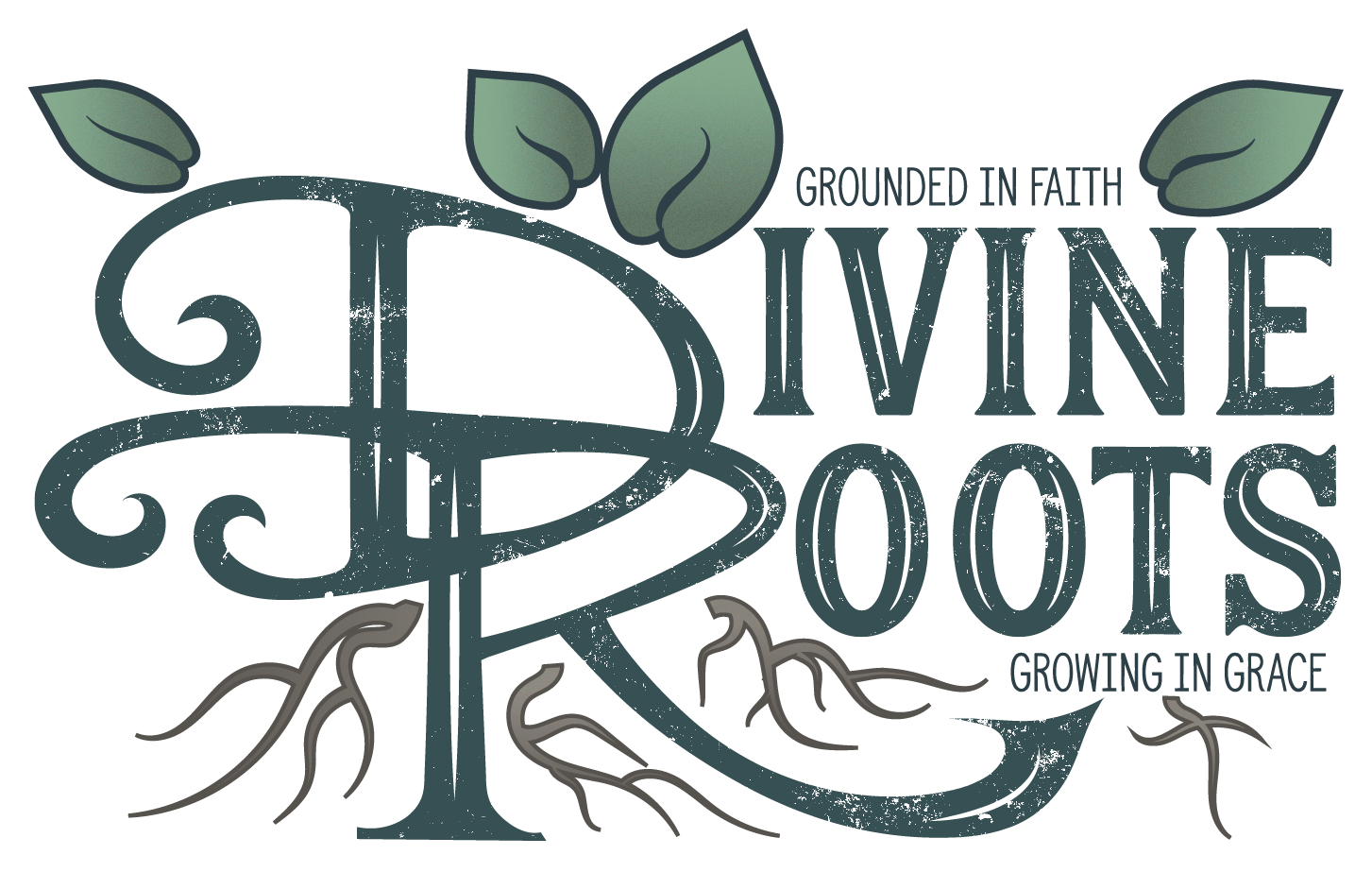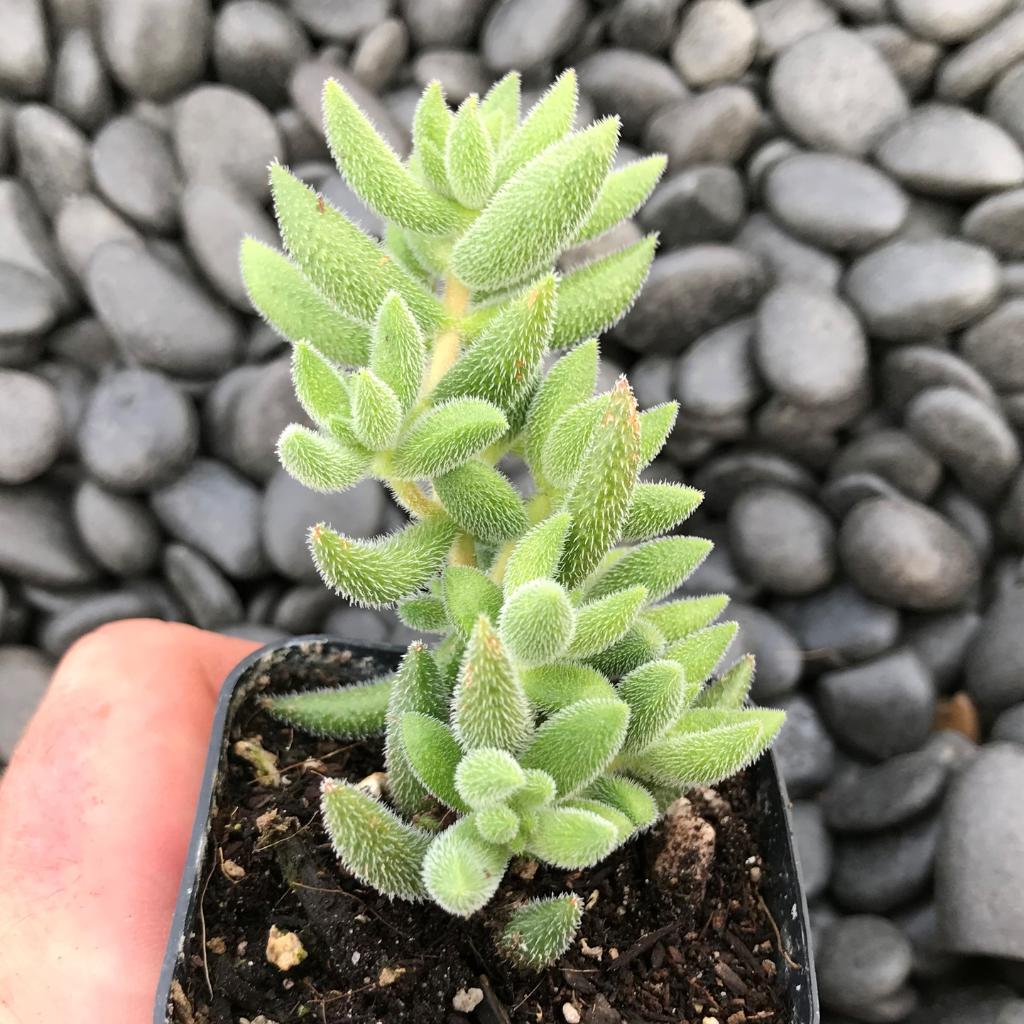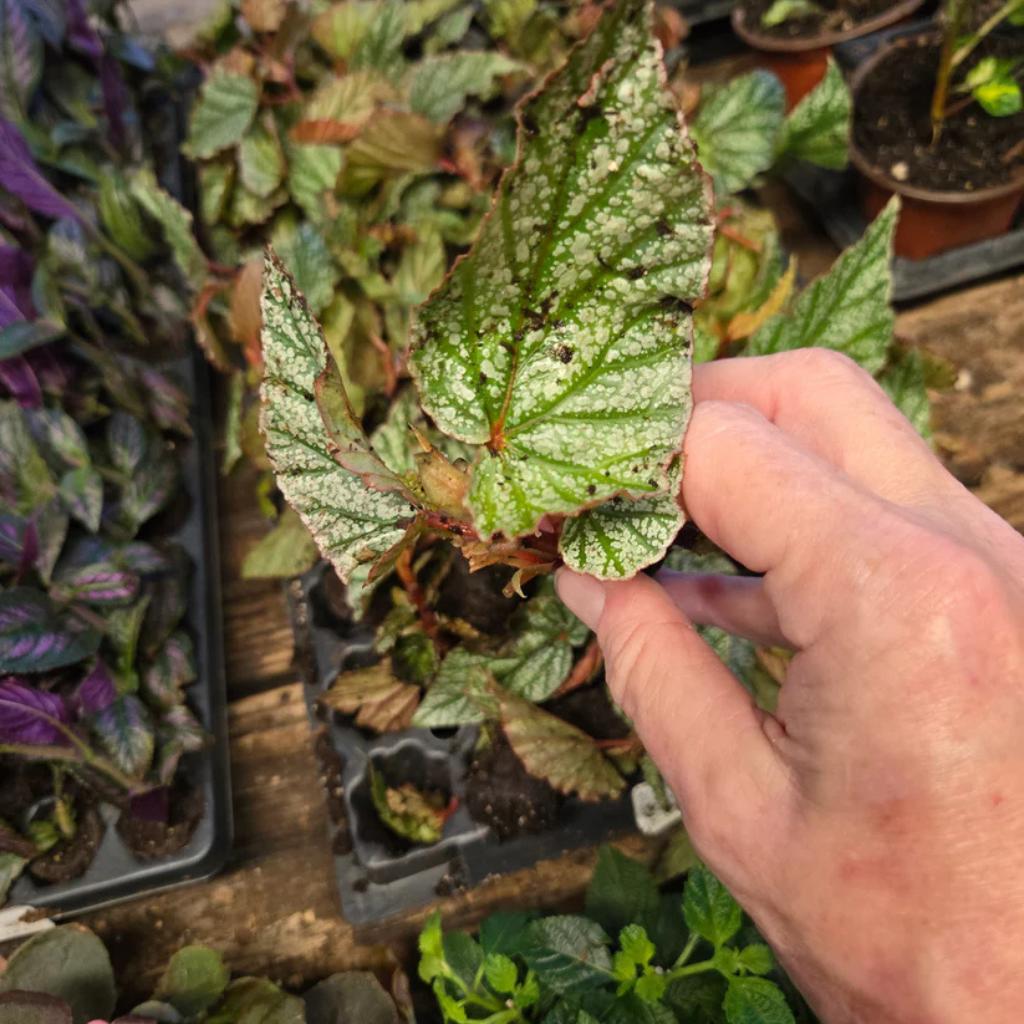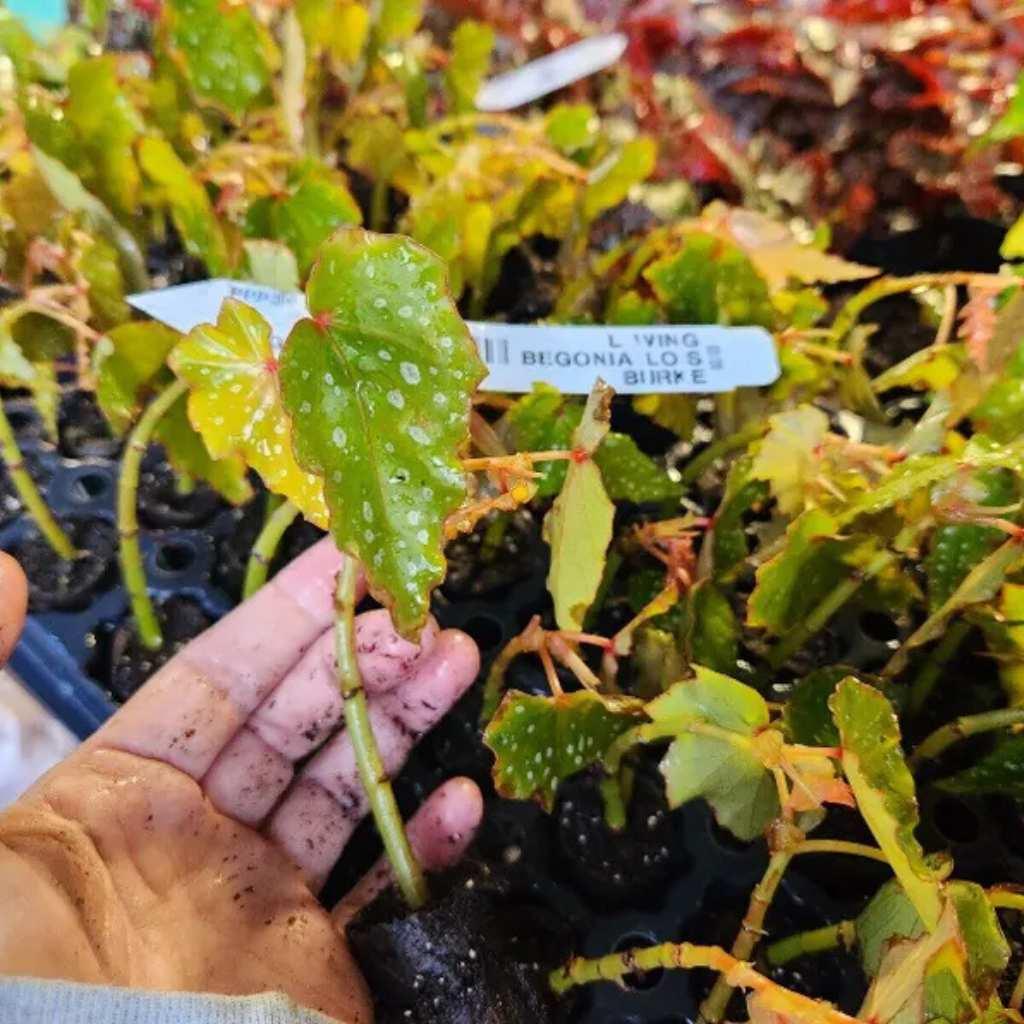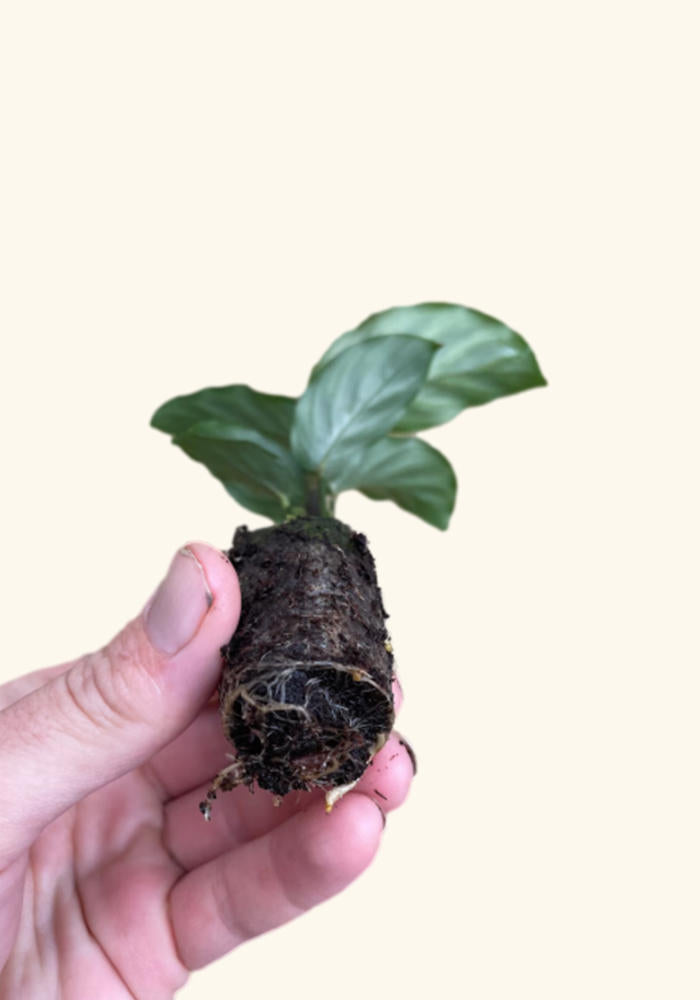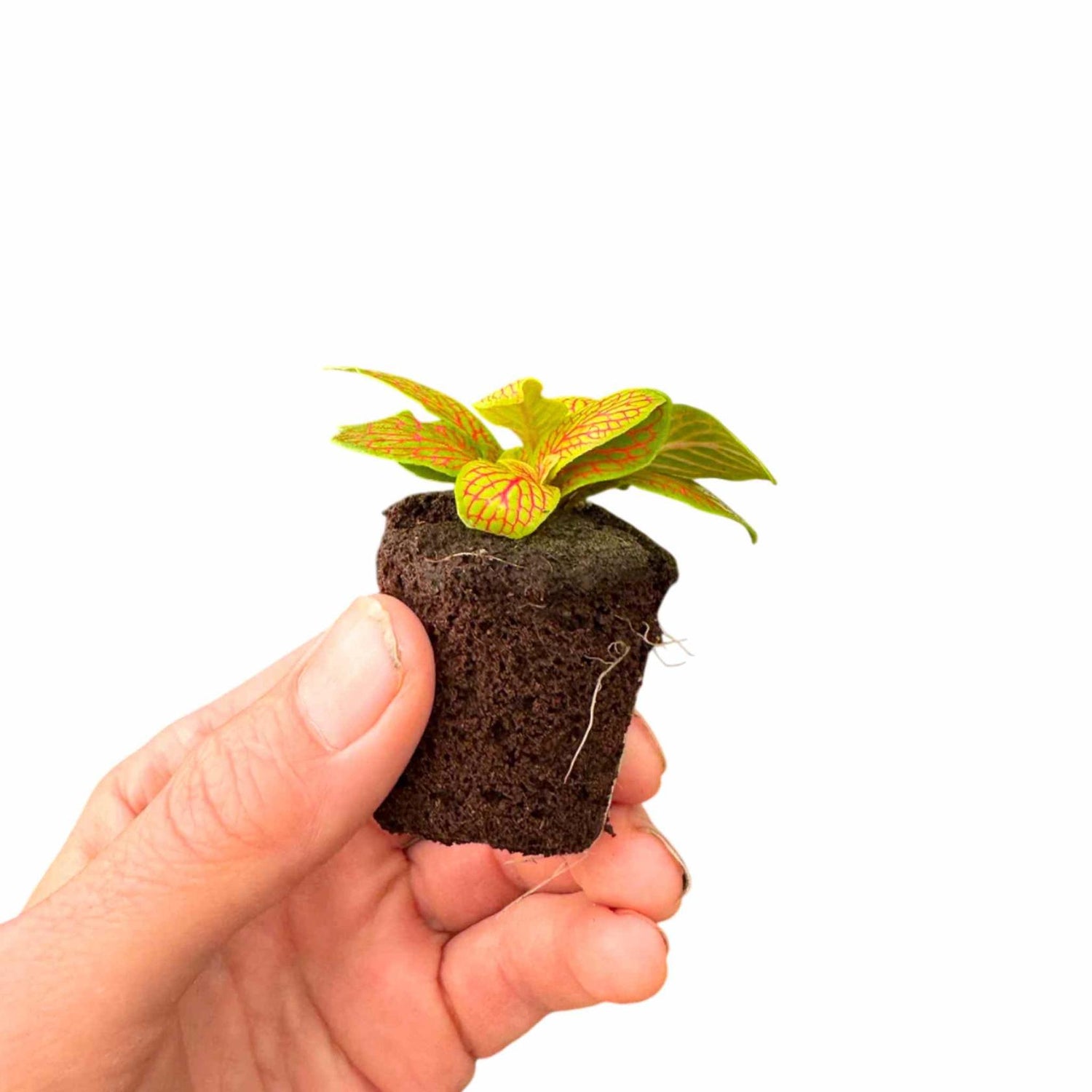Sort by:
71 products
71 products
The Crassula Mesembryanthemoides Rooted Starter Plant is a young, pre-rooted succulent prized for its unique, stacked, pagoda-like foliage. Native to South Africa, this Crassulaceae family member features tightly packed, triangular green leaves that form vertical columns, resembling a miniature tower. The rooted starter is acclimated for easy growth and will mature into a compact plant reaching 4-6 inches tall, with potential for small white or pink blooms under bright light
Perfect for beginners, this drought-tolerant succulent offers a head start over seeds or cuttings, ensuring faster establishment and reduced transplant shock.
Crassula Mesembryanthemoides: Benefits
- Architectural appeal: Geometric foliage adds striking texture to desks, shelves, or terrariums.
- Drought-tolerant: Thrives with minimal watering, ideal for forgetful plant owners.
- Non-toxic: Safe for homes with pets and children.
- Compact growth: Fits small spaces or mixed succulent arrangements.
- Low maintenance: Requires no pruning or fertilizing.
Crassula Mesembryanthemoides Care Guide
Light and Water
- Light: Bright, indirect light to partial sun (east or south-facing windows). Direct morning sun enhances leaf density; avoid intense afternoon sun.
- Water: Water sparingly every 3-4 weeks in summer. Let the soil dry completely between waterings. Reduce to monthly in winter.
Soil and Fertilizing
- Soil: Use a gritty cactus/succulent mix (e.g., 50% potting soil + 50% perlite/pumice).
- Fertilizer: Optional feed lightly with diluted succulent fertilizer (5-10-5) once in spring and summer.
Temperature and Humidity
- Temperature: Ideal range: 60-80°F (15-27°C). Protect from frost and temperatures below 40°F (4°C).
- Humidity: Thrives in dry conditions (10-40% humidity). Avoid high humidity.
Pruning, Propagating, and Repotting
- Pruning: Trim leggy stems to maintain shape. Remove dead leaves at the base.
- Propagating: Take stem or leaf cuttings; let callous for 1-2 days before planting in dry soil.
- Repotting: Repot every 2-3 years in spring. Use shallow pots to accommodate shallow roots.
Common Problems
- Root rot: Overwatering or poor drainage. Ensure pots have drainage holes.
- Etiolation (stretching): Insufficient light. Move to a brighter location.
- Mealybugs: Treat with neem oil or isopropyl alcohol.
- Sunburn: White/brown patches from sudden, intense sun exposure. Acclimate gradually.
Crassula Mesembryanthemoides: Best Locations & Uses
- Sunny windowsills: Enhance leaf density with morning sunlight.
- Rock gardens: Add vertical interest among stones or gravel.
- Terrariums: Compact size suits arid, open terrarium setups.
- Office desks: Thrives under bright artificial light.
- Pet-friendly spaces: Safe for households with cats or dogs.
The Angel Wing Begonia Snow Capped Rooted Starter Plant is a young, established specimen of this striking tropical begonia, known for its unique foliage with silvery-white edges that resemble snow-dusted wings. A member of the Begoniaceae family, this cane begonia features large, asymmetrical leaves with deep green centers and frost-like margins, complemented by red undersides. Originating from South America’s humid forests, this rooted starter is pre-acclimated for indoor growth and will mature into a lush plant reaching 18-24 inches tall, with potential for delicate pink or white flowers under optimal conditions.
Ideal for beginners, this rooted plant offers a head start over cuttings or seeds, ensuring faster establishment and reduced transplant shock.
Angel Wing Begonia Snow Capped: Benefits
- Unique foliage: Silvery-white leaf margins add wintery elegance to indoor spaces.
- Air-purifying: Filters indoor pollutants like benzene and formaldehyde.
- Established roots: Reduces care challenges compared to unrooted cuttings.
- Compact growth: Suitable for shelves, tabletops, or hanging baskets.
- Propagation-ready: Once mature, easily propagate via stem cuttings.
Angel Wing Begonia Snow-Capped Care Guide
Light and Water
- Light: Bright, indirect light (east or west-facing windows). Avoid direct sun to prevent leaf scorch.
- Water: Keep soil lightly moist. Water when the top 1 inch of soil dries. Reduce watering in winter.
Soil and Fertilizing
- Soil: Use a well-draining, peat-based mix with perlite or orchid bark.
- Fertilizer: Begin feeding 4-6 weeks after potting with a balanced liquid fertilizer (10-10-10) monthly during spring-fall.
Temperature and Humidity
- Temperature: 65-75°F (18-24°C). Avoid drafts and temperatures below 55°F (13°C).
- Humidity: Maintain 50-60% humidity. Use a pebble tray or humidifier; avoid misting foliage.
Pruning, Propagating, and Repotting
- Pruning: Trim leggy stems once established to encourage bushiness.
- Propagating: After maturity, take 4-6 inch stem cuttings with nodes and root in water or soil.
- Repotting: Repot into a 1-2 inch larger pot when roots outgrow the starter container (typically in 6-12 months)
Common Problems
- Powdery mildew: Improve airflow and avoid wetting leaves.
- Root rot: Overwatering or poor drainage. Ensure pots have drainage holes.
- Mealybugs/spider mites: Treat with neem oil or insecticidal soap.
- Leaf discoloration: Direct sun exposure or nutrient deficiencies. Adjust the light or fertilization.
Angel Wing Begonia Snow Capped: Best Locations & Uses
- Bright indoor spaces: Showcases foliage as a tabletop or shelf centerpiece.
- Humid bathrooms: Thrives in ambient moisture with indirect light.
- Hanging baskets: Trails gracefully once mature, ideal for patios or sunrooms.
- Terrariums: Suitable for large, open terrariums with airflow.
- Pet-free homes: Toxic to cats and dogs if ingested.
The Angel Wing Begonia Lois Burke Rooted Starter Plant is a young, established cane begonia ready to grow into a stunning tropical specimen. Known for its large, wing-shaped leaves adorned with silver-white speckles and deep red undersides, this Begoniaceae family member originates from South America’s rainforests. The rooted starter features healthy stems and leaves, already acclimated to thrive in indoor environments. With proper care, it will mature to 18-24 inches tall, producing clusters of delicate pink or red flowers under bright, indirect light.
Ideal for beginners or collectors, this starter plant offers a head start in cultivating a lush, tropical display. Compared to seeds or unrooted cuttings, its established roots ensure faster growth and easier care.
Angel Wing Begonia Lois Burke: Benefits
- Ready to grow: Rooted starter ensures quicker establishment and reduced transplant shock.
- Aesthetic appeal: Speckled foliage adds tropical elegance to shelves, desks, or hanging baskets.
- Air-purifying: Filters indoor pollutants like benzene and formaldehyde.
- Compact potential: Manageable size suits small spaces while maturing into a statement plant.
- Propagation-ready: Once mature, easily propagate by stem cuttings.
Angel Wing Begonia Lois Burke Care Guide
Light and Water
- Light: Bright, indirect light (east or west-facing windows). Avoid direct sun to prevent leaf scorch.
- Water: Keep soil lightly moist. Water when the top 1 inch of soil dries. Reduce frequency in winter.
Soil and Fertilizing
- Soil: Use a well-draining, peat-based mix with perlite or orchid bark.
- Fertilizer: Begin feeding 4-6 weeks after potting with a balanced liquid fertilizer (10-10-10) monthly during spring-fall.
Temperature and Humidity
- Temperature: 65-75°F (18-24°C). Avoid drafts and temperatures below 55°F (13°C).
- Humidity: Maintain 50-60% humidity. Use a pebble tray or humidifier; avoid misting foliage.
Pruning, Propagating, and Repotting
- Pruning: Trim leggy stems once established to encourage bushiness.
- Propagating: After maturity, take 4-6 inch stem cuttings with nodes and root in water or soil.
- Repotting: Repot into a 1-2 inch larger container when roots outgrow the starter pot (typically in 6-12 months)
Common Problems
- Root rot: Overwatering in early stages. Ensure the starter pot has drainage holes.
- Leaf spots: Caused by water on leaves or fungal issues. Water at the soil level.
- Mealybugs/spider mites: Inspect regularly; treat with neem oil or insecticidal soap.
- Slow growth: Adjust light or humidity if conditions are suboptimal.
Angel Wing Begonia Lois Burke: Best Locations & Uses
- Bright tabletops: Showcases foliage as a desk or shelf centerpiece.
- Humid bathrooms: Thrives in indirect light and ambient moisture.
- Starter terrariums: Suitable for open, humid terrariums with airflow.
- Gift plant: Perfect for gifting to tropical plant enthusiasts.
- Pet-free zones: Toxic to cats and dogs if ingested.
The Calathea Freddie, also known as the "Peacock Plant," is a stunning tropical plant known for its vibrant foliage and eye-catching pattern. With its striking, dark green leaves adorned with intricate purple and light green markings, this plant adds a touch of elegance to any space. Native to the rainforests of South America, Calathea Freddie thrives in humid, shaded environments, making it an ideal choice for indoor gardening. As a relatively compact plant, it fits well into smaller spaces and is a perfect addition to your home or office.
Calathea Freddie is a low-maintenance plant that’s great for both beginner and experienced gardeners. With its non-toxic nature, it’s also a safe choice for homes with pets. Known for its unique "prayer-like" movement, the plant's leaves fold up at night, giving it a beautiful and dynamic quality as it adapts to its environment.
Calathea Freddie: Benefits
- Beautiful foliage with striking patterns
- Great air purifier that improves indoor air quality
- Non-toxic to pets, making it safe for households with animals
- Ideal for adding a tropical touch to your home
- Low-maintenance and easy to care for
- Unique, dynamic leaf movement
Calathea Freddie: Alternative Names
- Peacock Plant
- Cathedral Plant
- Zebra Plant
Calathea Freddie Care Guide
To keep your Calathea Freddie healthy and thriving, following these essential care guidelines is key:
Watering
Calathea Freddie likes its soil to remain consistently moist but not waterlogged. Water when the top inch of soil feels dry to the touch, ensuring proper drainage to prevent root rot. Use lukewarm, filtered water if possible, as the plant can be sensitive to chemicals often found in tap water.
Light and Temperature
This plant prefers bright, indirect light but can tolerate lower light conditions. However, avoid direct sunlight as it can scorch its beautiful leaves. It thrives in temperatures ranging from 65°F to 80°F (18°C to 27°C), so be sure to keep it away from cold drafts and heaters.
Humidity
As a tropical plant, Calathea Freddie loves humidity. To create an ideal environment, regularly mist the leaves, place the plant on a humidity tray, or group it with other plants to increase moisture in the air. The more humidity, the better the plant will thrive.
Soil, Repotting, and Fertilizing
Calathea Freddie thrives in a well-draining, moist soil mix, such as a mix designed for tropical plants or a combination of peat, pine bark, and perlite. Repot your plant every 1-2 years or when it becomes root-bound, typically in the spring. Use a balanced, liquid fertilizer diluted to half-strength once a month during the growing season (spring and summer).
Propagation
You can propagate your Calathea Freddie by dividing the plant when repotting. Gently separate the root ball into smaller sections, ensuring each has roots and a healthy portion of foliage. Place the new divisions into their pots with fresh, well-draining soil and water them well.
Pruning, Cleaning, and Common Issues
Prune any yellowing or dead leaves to keep the plant looking tidy and healthy. Calathea Freddie is known for being sensitive to changes in light, temperature, and moisture levels, so it may drop leaves if the environment is not ideal. Common issues include brown leaf tips, which are often a result of dry air or inconsistent watering. Regularly wipe down the leaves with a damp cloth to keep them clean and free of dust.
Calathea Freddie: Placement, Companion & Alternative Plants
Whether you place it in your living room, office, or bedroom, the Calathea Freddie is sure to enhance your space with its bold, decorative leaves and calm presence.
Best Locations & Uses
- Ideal for homes with pets as it’s non-toxic
- Great for adding a pop of tropical color to any room
- Perfect for offices, bedrooms, or living spaces where humidity can be maintained
- A lovely gift for plant enthusiasts
- Adds vibrancy and life to indoor environments
Companion Plants
Group your Calathea Freddie with other humidity-loving plants to create an indoor tropical paradise! Here are some great companions:
- Prayer Plant (Maranta leuconeura): A close relative, the Prayer Plant shares the same vibrant leaf patterns and dynamic movement.
- Ferns (Nephrolepis exaltata): Ferns, like the Boston Fern, thrive in similar conditions of moisture and humidity, complementing the Calathea Freddie beautifully
- Peace Lily (Spathiphyllum): A great air-purifying companion, the Peace Lily’s dark leaves and white blooms provide a stunning contrast to the Calathea Freddie’s vibrant foliage.
Alternative Plants
If you’re looking for similar plants that offer lush foliage and striking patterns, consider these options:
- Calathea Orbifolia: Known for its large, round leaves with silver-green stripes, the Calathea Orbifolia is another stunning option for your indoor garden.
- Calathea Medallion: This variety features deep green leaves with lighter, silvery markings, making it a beautiful alternative.
- Bromeliads: With their colorful blooms and preference for humid environments, Bromeliads make an attractive addition to any plant collection.
Add a Calathea Freddie to Your Indoor Garden!
Bring tropical beauty into your home with a Calathea Freddie rooted starter plant. This vibrant, pet-friendly houseplant will not only brighten up your space but will also improve the air quality and add a touch of elegance.
The Fittonia Skeleton, commonly known as the Nerve Plant, is a stunning tropical houseplant admired for its intricate foliage. Its deep green leaves are strikingly veined with a crisp white or light green pattern, giving it a "skeleton-like" appearance. This compact plant belongs to the Acanthaceae family and hails from the tropical rainforests of South America, where it thrives in the humid understory. As an indoor plant, it brings a touch of nature’s artistry into your home with its unique texture and vibrant look.
The Fittonia Skeleton is an ideal choice for small spaces, as it stays compact and bushy, making it perfect for tabletops, terrariums, or shelves. This rooted starter plant is a great option for plant lovers looking to cultivate a visually striking, easy-to-care-for addition to their indoor garden.
Fittonia Skeleton: Benefits
- Compact and decorative plant for small spaces
- Air-purifying qualities
- Easy to grow and maintain
- Thrives in humid environments
- Adds vibrant greenery to any space
Fittonia Skeleton: Alternative Names
- Nerve Plant
- Mosaic Plant
Fittonia Skeleton Care Guide
Although Fittonia Skeleton is low-maintenance, understanding its care needs will ensure it stays vibrant and healthy.
Watering
This plant loves consistently moist soil. Water it when the top inch of soil feels dry, ensuring the pot has proper drainage to prevent overwatering. Be cautious not to let the soil dry out completely, as Fittonia can wilt quickly but recovers well when rehydrated.
Light and Temperature
Fittonia Skeleton thrives in bright, indirect light. Direct sunlight can scorch its delicate leaves, while too little light may fade its vibrant veins. It grows best in temperatures between 65°F and 85°F and should be protected from cold drafts or sudden temperature changes.
Humidity
This tropical plant loves high humidity. Regular misting, placing it on a pebble tray filled with water, or using a humidifier will keep your Fittonia happy. It's an excellent choice for bathrooms or kitchens where humidity levels tend to be higher.
Soil, Repotting, and Fertilizing
Use a well-draining, nutrient-rich potting mix to ensure proper root health. Fittonia doesn’t require frequent repotting; repot every 1-2 years or when the roots outgrow the container. Fertilize monthly during the growing season with a balanced liquid fertilizer diluted to half-strength to encourage lush foliage.
Pruning and Propagation
Prune regularly to maintain its bushy shape and remove any yellowing or leggy growth. Propagation is simple: take stem cuttings with at least two nodes, place them in water or moist soil, and watch roots develop before transplanting to a pot.
Fittonia Skeleton: Placement, Companion & Alternative Plants
The Fittonia Skeleton's compact size and vibrant foliage make it a versatile addition to your plant collection.
Best Locations & Uses
- Perfect for terrariums, desktops, or shelves
- A great choice for humid spaces like bathrooms or kitchens
- Ideal for beginner indoor gardeners or as a gift plant
- Adds a pop of greenery to small apartments or offices
Companion Plants
Pair your Fittonia Skeleton with plants that thrive in similar humid and low-light conditions:
- Fern (Nephrolepis exaltata): This lush, feathery plant complements the compact Fittonia with its flowing fronds.
- Peperomia Rosso: Its compact size and unique textured leaves make it a beautiful companion.
- Spider Plant (Chlorophytum comosum): An easy-care plant with arching green-and-white leaves to contrast with Fittonia’s intricate patterns.
Alternative Plants
If you love the Fittonia Skeleton’s aesthetic, consider these alternatives:
- Calathea Medallion: Known for its bold and colorful patterns, this plant offers a dramatic focal point.
- Tradescantia Zebrina: With its purple-and-silver-striped foliage, this trailing plant adds visual interest.
- Pilea Peperomioides: The popular Chinese Money Plant’s round leaves make it a delightful addition to any indoor collection.
Add a Fittonia Skeleton to Your Indoor Garden!
Bring home a Fittonia Skeleton Rooted Starter Plant and enjoy its intricate beauty and low-maintenance nature. Whether you’re a seasoned plant enthusiast or a beginner, this charming plant is sure to enhance your space and bring a touch of tropical elegance to your home.

